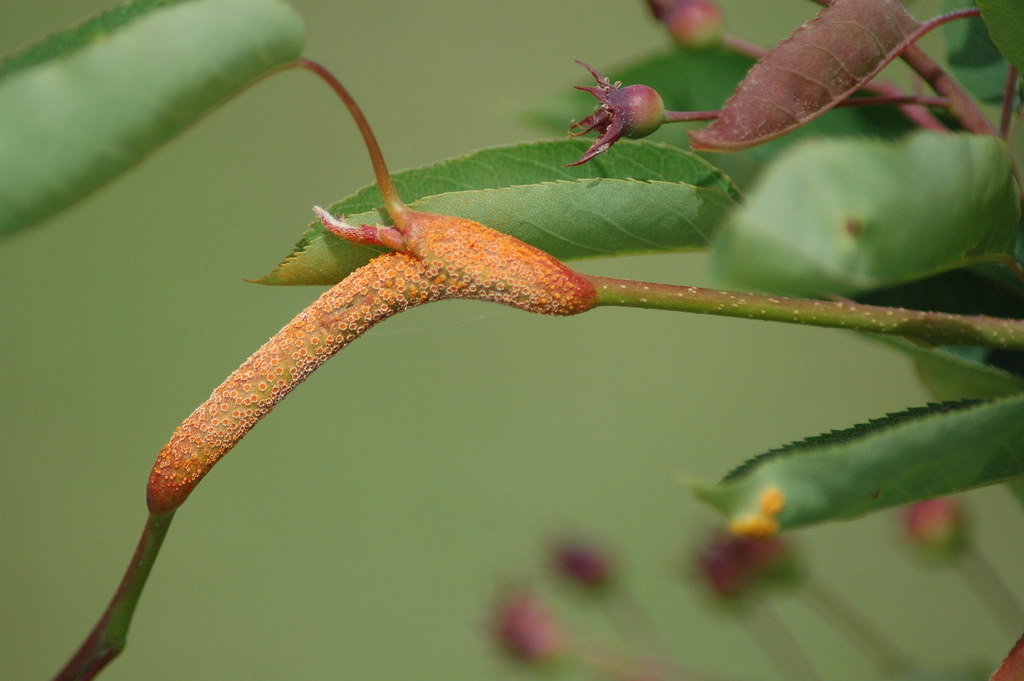
Pear rust
Gymnosporangium libocedri
What is Pear rust (Gymnosporangium libocedri)?
Pear rust, caused by the fungus Gymnosporangium libocedri, is a plant disease that affects pear trees and certain other plants in the Rosaceae family. It is primarily found in regions with a suitable climate, such as the Pacific coast of North America. Infected plants include pears, apples, quinces, hawthorns, mountain ash, and serviceberries. Symptoms of pear rust manifest as discolored spots on leaves, fruit, and green stems, with powdery or rough spore masses. Cup-shaped pustules (aecia) containing spore-forming bodies can be seen on infected plant parts.
How does Pear rust (Gymnosporangium libocedri) occur?
Pear rust (Gymnosporangium libocedri) reproduces through a complex life cycle involving two host plants. The fungus produces spores on incense cedar during spring, which are then dispersed by air to infect young tissues of pear trees and other rosaceous hosts. In the infected hosts, the fungus grows and produces airborne spores that can reinfect incense cedar later in the season. This alternating infection between the two hosts allows the fungus to persist and spread, particularly during periods of wet weather that favor disease development.
Symptoms
1 - Impact on Plants
Pear rust can reduce plant vigor and productivity. Infected trees and rosaceous hosts develop spots, distorted leaves, premature fruit drop, and even defoliation, impacting their overall health.
2 - Soil Health
While pear rust does not directly affect soil, it can indirectly influence soil fertility. Reduced plant vigor and fruit drop can lead to decreased organic matter inputs and nutrient cycling, potentially affecting soil health over time.
3 - Impacts on Environment
Pear rust disrupts plant ecosystems and aesthetics. Fungal spores released during the disease cycle can spread to susceptible plants in natural habitats, gardens, and landscapes, impacting local environments.
Solutions
1 - Cultural Practices
• Remove alternate hosts such as incense cedar trees around the orchard to reduce the source of infection. • Plant resistant tree varieties when available. • Practice good sanitation by removing fallen leaves or infected plant debris. • Avoid overhead watering, as wet conditions promote disease development. • Maintain overall tree health through proper fertilization and regular inspections.
2 - Chemical Control
Recommended fungicides for controlling pear rust include Aprovia, Flint Extra, Fontelis, Inspire Super, Miravis, Ph-D WDG, Procure 480 SC, Rhyme, Tebucon 45 DF, Topguard SC, and Trionic 4 SC. Follow the instructions on the fungicide labels regarding application rates and timing.
3 - Chemical Control for Flowering Pear
Fungicides such as Eagle 20 EW, Heritage, Insignia SC, Myclobutanil 20 EW T&O, ProStar 70 WG, Spectracide Immunox Multi-Purpose Fungicide Spray Concentrate for Gardens, and Tourney EZ can be used for flowering pear trees. Follow the instructions on the fungicide labels for application rates and timing.
